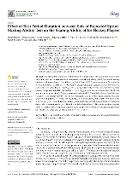Effect of Rest Period Duration between Sets of Repeated Sprint Skating Ability Test on the Skating Ability of Ice Hockey Players

Autor
Baron, Jakub
Gupta, Subir
Bieniec, Anna
Datum vydání
2021Publikováno v
International Journal of Environmental Research and Public HealthRočník / Číslo vydání
18 (20)ISBN / ISSN
ISSN: 1661-7827Metadata
Zobrazit celý záznamKolekce
Tato publikace má vydavatelskou verzi s DOI 10.3390/ijerph182010591
Abstrakt
The aim of this study was to determine the effects of two different rest periods, 2 min and 3 min, between consecutive sets of a repeated sprint skating ability (RSSA) test, on the skating ability of ice hockey players. Two RSSA tests, RSSA-2 and RSSA-3, were assessed on 24 ice hockey players. In RSSA-2, six sets of 3 x 80 m sprint skating, with 2 min passive recovery between two consecutive sets was allowed. In RSSA-3, the recovery period between the sets was 3 min. Average speed, average heart rate (HRaver), peak heart rate (HRpeak), blood lactate concentration ([BLa]), and rate of perceived exertion (RPE) were measured in both RSSA-2 and RSSA-3 tests. In all the sets, except set 1, the average speed of the subjects was significantly (p < 0.05) higher in RSSA-3 than the respective set in RSSA-2. Average HR and RPE were higher in RSSA-2 than RSSA-3 in most of the sets. For any given set, no difference in HRpeak was noted between RSSA-2 and RSSA-3. Post-sprint (Set 6) [BLa] was significantly (p < 0.05) higher in RSSA-3 than RSSA-2. This study concludes that the 3 min rest period is more beneficial than the 2 min rest period, for (1) increasing skating speed and (2) reducing overall cardiac workload and perceived fatigue.</p>
Klíčová slova
average speed, blood lactate concentration, rate of perceived exertion, speed decrement, average heart rate, peak heart rate
Trvalý odkaz
https://hdl.handle.net/20.500.14178/1629Licence
Licence pro užití plného textu výsledku: Creative Commons Uveďte původ 4.0 International







